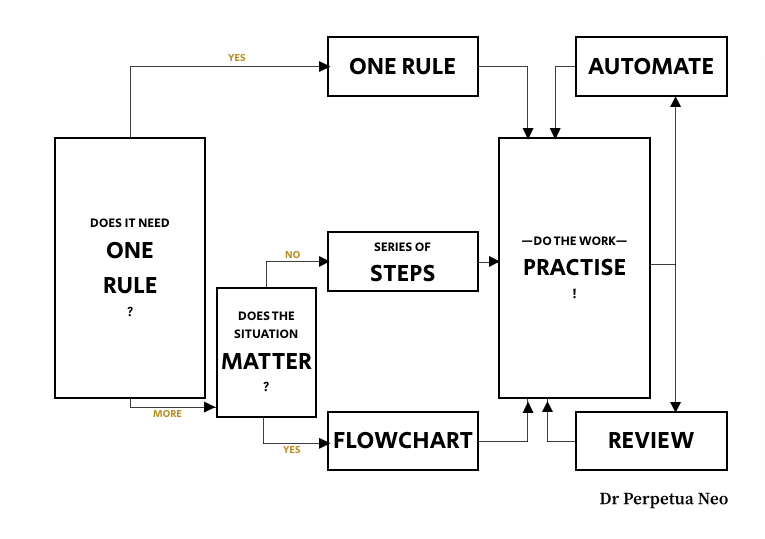If you’re feeling overwhelmed, then your mechanical world probably isn’t going right. “But what is my mechanical world”, you ask? Imagine yourself as a house. In it are your possessions, your achievements and everything else that’s going right or wrong. What do you see? Never-ending emails, bills to pay, dogs to groom, a body you’re getting less satisfied with… It’s all too much. Now, go behind the walls, inside the floor and ceiling boards, and into the foundations. We take for granted how pipes, electricity cables and invisible machinery drive our house.
Flicking the light switch isn’t a magickal command “Let there be light”. It’s the cogs and wheels that create your processes. Your (consistent) success hinges on your systems. They help you to build new habits even when you don’t feel motivated. Yet we forget or ignore them, in handling the emails, bills, bodies, etcetera. But imagine, more time. More sanity. More control. More energy. If you’re serious about changing your life and creating lasting change, then systems are the way to go.
The Big Questions
“WHY GO DEEP WHEN I CAN HACK IT?”
Sam Carpenter, author of Work The System and CEO of Centratel, is a Systemsvangelist. I agree with him. He says that the biggest difference between very successful people and others, is that successful people tweak their cogs and wheels. It’s not about simply trying harder so your emails, money problems, anxiety, etcetera, will go away. They’re merely symptoms. Trying harder is caking on concealer on bad skin without eating cleaner or taking medication. Just like using Quick Wins and realising the effect doesn’t last. Because what you don’t know about your mind will trip you up.
“NO TIME!”– LIMITING BELIEFS THAT TRIP YOU UP
But why do we avoid going deeper into our minds and our houses’ foundations? We tell ourselves we are fighting fires everyday- “Do you know just how much I’ve just done?” and we’re proud of it. Or, we think we don’t have time. But if poor processes eat our time, then the time (and energy) debt builds up. It’s a vicious cycle, a downward spiral. Learning about your limiting beliefs can be enlightening. And being honest with yourself, asking yourself how badly you want this change to happen.
“BUT THIS MAKES ME ANGRY!”– MAKE IT NON-EMOTIONAL
Handling a mountain of emails. Fighting with your partner over the toilet seat. Looking at your finances. These are emotional topics. And there’s a mechanical, boring and un-sexy part that isn’t emotional. It’s the cogs and wheels. And it’s the only thing you can control.
Creating Your Systems

What parts of your life would you like to change? To tweak your system, you must be clear. And then, to decide if this system involves One Rule or a Streamlined Strategy. Here’s what they are both about.
ONE RULE
There are things we can solve by committing to One Rule. Ramit Sethi and Sam talked about how outcomes are erratic on the Toilet Seat Issue. Because we make it a decision everyday. We ask “Do I put it down? Do I feel good? Do I like my partner?” But what if it’s not about power? Rather, a flaw in one system of two people’s lives together. Imagine if this is replaced by One Rule- “I’ll always put it down”. No more brain juice wasted debating minutiae and getting emotional. We can get on with our lives. More peace.
More examples?
- Gretchen Rubin sets an alarm for bedtime, so she has enough sleep.
- Steve Job’s Wear The Same T-Shirt Everyday.
- I love Alexandra Franzen’s “Your mission is to leave everything — apartments, national parks, people’s hearts — in better condition than you found them.”
STREAMLINED STRATEGY
There are so many ideas, hacks and methods for everything. Everybody has an opinion on how to do everything. No wonder we’re overwhelmed. Streamlined Strategy is for those things where you need a Series of Steps, or a Flowchart to guide your process.
- Series Of Steps: My inbox used to have 5000 unread messages. Now, I have (1) things I read occasionally and (2) things I need to respond to. I’ve created filters where (1) can bypass my inbox. So when I want to read the emails from Ramit or Danielle LaPorte, they’ve a folder each, under the bigger category “To Read”. There are 57 folders, with a hierarchical logic. No confusion, only sanity. As for (2), I label them with “Urgent” or “Can Wait”. I have templates to reply or write certain emails. I unsubscribe from what I don’t want immediately. This way, my inbox is always empty. I sleep happily. This Series of Steps can be applied to anything- from managing your money to how to leave your house in 35 minutes (and meditate).
- Flowcharts: There are some things where we need to make decisions in different situations. Especially when you’re in the early stages of building or breaking a habit. Like how I’ve illustrated Creating A System. Or in what to do with your thoughts and stop worrying. How to handle motivation and do more. How to stop procrastinating by deciding on what’s Good Enough. How to react vs respond. My clients love flowcharts because they help them understand what they’ve been doing without thinking, and what they can do differently. There’s a flowchart for handling each scenario and solving each problem. Draw them out, take a photo, use it as your wallpaper (temporarily). Making it visual makes it real and more memorable.
Cogs & Wheels: The Gold Edition of creating lasting change
“WHAT CAN I AUTOMATE?”
I love automation. It goes with the spirit of cogs and wheels. Ramit, a personal finance expert, spends less than an hour monthly on his personal finance system. His savings, payments and investments happen automatically. To me, automation is outsourcing to a machine. Picture it this way, you order a vegetable box from the local farm and you’ll make the habit of eating clean and ethically much easier. You set your bank account to save £300 monthly, and you’ll have £3600 at the end of the year before interest.
REVIEW YOUR SYSTEMS
Success Expert Cal Newport recommends that you learn to expect failure and feel stuck. Cal has a system on top of his system. Every month, he schedules a review to (1) adjust a project to become better calibrated and (2) quit working on it if it’s the wrong project. This way, he can work without spending mental effort worrying everyday, knowing that he’ll address it during his review. “But I don’t have a month to waste”, you say. Let’s reframe it this way, if you’ve spent months or years struggling, a month to experiment can be a small speck in the grand scheme of things. Or, twice-monthly reviews.
Reviewing gives you sanity and allows you to improve your system better. A win-win.
Want to procrastinate and accomplish even more, and make that wonderful mind of yours work for you? I work with high-performing clients in 8-week VIP programs tailored to your goals, personality and lifestyle. Book your free Chemistry Call here.





